#Robotics Industry 2023
Explore tagged Tumblr posts
Text
The Robot Uprising Began in 1979
edit: based on a real article, but with a dash of satire

source: X
On January 25, 1979, Robert Williams became the first person (on record at least) to be killed by a robot, but it was far from the last fatality at the hands of a robotic system.
Williams was a 25-year-old employee at the Ford Motor Company casting plant in Flat Rock, Michigan. On that infamous day, he was working with a parts-retrieval system that moved castings and other materials from one part of the factory to another.
The robot identified the employee as in its way and, thus, a threat to its mission, and calculated that the most efficient way to eliminate the threat was to remove the worker with extreme prejudice.
"Using its very powerful hydraulic arm, the robot smashed the surprised worker into the operating machine, killing him instantly, after which it resumed its duties without further interference."
A news report about the legal battle suggests the killer robot continued working while Williams lay dead for 30 minutes until fellow workers realized what had happened.
Many more deaths of this ilk have continued to pile up. A 2023 study identified that robots have killed at least 41 people in the USA between 1992 and 2017, with almost half of the fatalities in the Midwest, a region bursting with heavy industry and manufacturing.
For now, the companies that own these murderbots are held responsible for their actions. However, as AI grows increasingly ubiquitous and potentially uncontrollable, how might robot murders become ever-more complicated, and whom will we hold responsible as their decision-making becomes more self-driven and opaque?
#tech history#robots#satire but based on real workplace safety issues#the robot uprising#killer robots#artificial intelligence#my screencaps
4K notes
·
View notes
Text
#Global Muscle Wire Market Size#Share#Trends#Growth#Industry Analysis By Types( One - Way#Two - Way )#By Applications( Aerospace#Textile Electronics#Arterial Stints#Robotics#Orthodontic Braces#Eyeglasses#Others )#Key Players#Revenue#Future Development & Forecast 2023-2032
0 notes
Text
Tech-Ninja AU Lore & PV?
If you think yokai ninja AU is the craziest idea I've ever had...think again :D

In a corner of my Ninjavember 2023, I briefly mentioned this au, merely a tip of an iceberg.
The lore is mainly inspired by a weird dream and episode 39 of season 1(McSatchle): What if Howard really becomes Randy's boss? Worse yet, what if they'll be like Mcfist and Viceroy?
Yeah, just punch me already🤣*wheeze*
In this AU, Randy didn't get chosen to be a ninja in his highschool years. Instead, he has good grades and a talent for inventing and technology, and eventually got into Mcfist industries with Viceroy as his mentor. Things went downhill as he discovered the true face of Mcfist. After the present ninja was killed by his own invention "the ninja armor", Randy could only turn to Howard.
Though, he's pretty sure he didn't install an AI calling themself "Nomicon"...
Howard is a talented businessman (He's good at chess, some sorts of smart game, so it kinda make sense?) who started his own company in a young age. He and Randy promised to run a company together when they were in highschool. So he was kinda frustrated that Randy chose Mcfist over him after college graduation. Of course Howard won't go easy on his old friend when he turned to him...
Howard and Randy being boss and employee is probably the funniest part of the AU. The rest are just pure angst😗
With Randy finally joined the Weinerman company, they began to catch up with the Mcfist industries. Yep, the story is mainly about business wars and science stuffs, which is another one of my blind spots. So no long comic for this one :P
There're also typical Ninja fighting robots and monsters stuffs, only this time, Randy isn't loved by everyone.
67 notes
·
View notes
Video
youtube
2025 January 5
Rocket Launch as Seen from the International Space Station Video Credit: ISAA, NASA, Expedition 57 Crew (ISS); Processing: Riccardo Rossi (ISAA, AstronautiCAST); Music: Inspiring Adventure Cinematic Background by Maryna
Explanation: Have you ever seen a rocket launch -- from space? A close inspection of the featured time-lapse video will reveal a rocket rising to Earth orbit as seen from the International Space Station (ISS). The Russian Soyuz-FG rocket was launched in November 2018 from the Baikonur Cosmodrome in Kazakhstan, carrying a Progress MS-10 (also 71P) module to bring needed supplies to the ISS. Highlights in the 90-second video (condensing about 15-minutes) include city lights and clouds visible on the Earth on the lower left, blue and gold bands of atmospheric airglow running diagonally across the center, and distant stars on the upper right that set behind the Earth. A lower stage can be seen falling back to Earth as the robotic supply ship fires its thrusters and begins to close on the ISS, a space laboratory that celebrated its 25th anniversary in 2023. Astronauts who live aboard the Earth-orbiting ISS conduct, among more practical duties, numerous science experiments that expand human knowledge and enable future commercial industry in low Earth orbit.
∞ Source: apod.nasa.gov/apod/ap250105.html
104 notes
·
View notes
Text
One of the staggering things the latest Cybertruck recall has revealed—other than Tesla’s use of the wrong glue—is that Elon Musk’s company appears to have sold 46,096 of these 7,000-pound electric pickups since customer deliveries began a little over 14 months ago. This is far fewer sales than Musk predicted for the Cybertruck just weeks before the rollout; he told investors that Tesla would soon sell 250,000 Cybertrucks per year.
On an earnings call a month before the November 2023 launch of the production vehicle, Musk boasted that Tesla had bagged “over 1 million” Cybertruck reservations and that “demand is off the charts.”
“Reservationists” initially paid $100 to join the queue, a refundable deposit later raised to $250. Car companies often open wait lists for models expected to outstrip supply, but most auto executives don’t expect that all of those who lodge deposits will follow through.
“The automotive industry aims for a conversion rate of around 2 to 16 percent” on reservations, Stephanie Valdez Streaty, director of industry insights for car tech firm Cox Automotive, tells WIRED.
By that reckoning, Tesla’s conversion rate is just under 5 percent. That’s at the lower end of the conversion scale, but many experts, used to Tesla’s stratospheric sales, might consider that a flop. Analysts generally don’t treat the world’s richest automaker like a regular car company. Its stock trades at many times earnings, valuing it multiples higher than companies that sell more cars.
If manufacturing capacity is any gauge of the sales numbers that Tesla was expecting, then the company must be sorely disappointed, because the Texas Gigafactory, where the Cybertruck is made, has the capacity to build more than 125,000 of the pickups per year. But, according to a Business Insider report from January, poor Cybertruck sales led to workers being taken off the “Cyber” production line and moved to a Model Y line.
Tesla’s current elevated worth is based not on its actual sales but on predicted sales of yet-to-be-launched robotaxis and humanoid Optimus robots, which—like the Cybertruck, slated to arrive three years before it went into production—could be several years away from being mass produced.
“My predictions have a pretty good track record,” Musk told Tesla staff at an all-hands meeting on March 20, but none of those present dared to ask him whether he had predicted the anti-Musk backlash that is tanking Tesla sales around the world.
And for all Musk’s bluster at the staff meeting that Tesla is “by far the most innovative company in the car industry,” it really isn’t. Chinese automakers such as XPeng, Nio, and Li Auto are far ahead of Tesla on autonomous driving and other technologies.
Waymo is already offering driverless taxi rides. Nor is Tesla the only company plotting a future for humanoid robots. In a recent TechFirst podcast, author Peter Diamandis stated there were 15 other companies also in this race—and none of those have a leader as controversial or as divisive as Musk.
“This year, we hopefully will be able to make about 5,000 Optimus robots,” said Musk. “That’s the size of a Roman legion. Which is like a scary thought. Like a whole legion of robots. I'll be like, ��whoa.’”
Musk’s exuberance continued as he claimed Tesla would make “probably 50,000-ish [Optimus robots] next year.” He further claimed that Optimus “will be the biggest product of all time by far—nothing will even be close. It’ll be 10 times bigger than the next biggest product ever made. Ultimately, I think we’ll be making tens of millions of robots a year.” Seconds later, he upped the ante even further, stating that, no, Tesla would actually make “maybe 100 million robots a year.”
Grandiose predictions excite Tesla bulls who believe him when Musk says “I know more about manufacturing than anyone currently alive on Earth,” but back in the real world Musk is in charge of a car manufacturing company that can’t even spec the correct grade of panel glue.
Now on its eighth recall in the past 14 months—prior recalls involved failing windshield wipers, trapped accelerator pedals, and possible loss of power to the wheels—Musk’s polarizing polygonic pickups are in sales free fall. Month-over-month Cybertruck sales were down by 32.5 percent in February, according to estimates by Cox Automotive.
“The Cybertruck generated significant buzz with its unique design and ambitious specifications,” says Cox’s Streaty. “However, sales have fallen short of expectations due to higher-than-promised prices, lower driving range and payload capacity, and production issues. The unconventional design hasn’t resonated with traditional truck buyers, and strong competition from Rivian and Ford has intensified the market.”
The Cybertruck, she adds, is a “niche product with a unique design and high price point, which may not resonate with mainstream consumers. Additionally, recalls and quality concerns can significantly undermine customer confidence and sales, posing a substantial challenge for the Cybertruck’s market success.”
When unveiled in 2019, Musk promised the production vehicle would launch within two years, starting with a $39,900 model. At the actual launch in 2023, the base model cost $21,000 more than that. The Foundation Series model—an early-doors special—cost an additional $20,000 despite offering no physical differences other than a look-at-me logo. Nonphysical perks included lifetime cellular connectivity and “free” access to Tesla’s Full Self-Driving (Supervised) system.
Forbes spoke with experts who estimate that Tesla sank at least $2 billion into the development of the Cybertruck. A traditional car might need 200,000 units per year to cover the research and development costs, Olav Sorenson, professor of strategy and sociology at UCLA and faculty director of its Price Center for Entrepreneurship & Innovation, has estimated.
Sorenson calculates that the Cybertruck, with its stainless steel body panels and unconventional construction, might require as many as 300,000 sales per year.
At current levels of Cybertruck sales Tesla “probably loses money on every one,” claims Sorenson. “It’s an innovative vehicle, but whether such an unusual design would appeal to consumers has always been a gamble. The DeLorean, the original stainless steel car, sold only about 9,000 units. Even more mainstream cars with unusual designs, such as the PT Cruiser, have struggled to reach profitable sales levels.”
Sadly for Tesla, Musk’s wedge wagon went from a million or more reservations—which many thought would take some years to work through—to walk-up availability at dealerships within months.
This swifter-than-expected softening of demand might have been partly due to the Cybertruck’s now notorious quality-control issues. “When we launched reservations for the Valkyrie, we knew that this would be a highly desirable car due to its limited production and the personnel involved in the car’s development,” says former Aston Martin CEO Andy Palmer. “People could rely on Aston and knew [the new car] was something we’d deliver. For the Cybertruck, we’ve seen a string of delays and a moving of the goalposts, which conveys a lack of reliability, and if the OEM isn’t reliable, why should customers be?”
A reservationist from northern Maryland, who says he was sold early on Musk’s promise of an electric pickup, spoke to WIRED on condition of anonymity. “I was planning on buying a truck and wanted my next vehicle to be electric,” he says. “At the time, the Cybertruck was the only EV pickup that seemed like it would be available soon. I placed an order with $100 refundable for the mid-tier one, but then the Cybertruck took much longer than originally promised, so I canceled my reservation.” He didn’t regret this decision. “With the events of the last couple of years, and especially the last couple of months, I would never now consider buying a Tesla vehicle.”
The deal breaker for many reservationists was the cost hike. “The Cybertruck was promised to start at $39,990 when the initial reservations began—a stratospheric difference from the $99,990 Foundation Series trucks that were first available,” says Joseph Yoon, consumer insights analyst at the car-shopping website Edmunds. “Even the cheapest base model now has an expected base MSRP of $60,990, and it’s likely that not many customers are willing to bridge the vast pricing gap.”
Tesla sold merely 38,965 of the angular EVs last year, according to Kelley Blue Book estimates. In January, Tesla introduced discounts to clear Cybertruck inventories with Foundation Series models still in stock, a variant Tesla was supposed to have stopped selling in October.
Tesla is now offering low financing rates to move Cybertrucks. Indeed, it has reportedly buffed out the badges on Foundation Series vehicles that failed to find a buyer so they can be sold as regular models. To clear yet more Foundation Series Cybertrucks from inventory, Tesla dealerships have also listed perks such as free lifetime Supercharging. The electric pickups are even piling up on used-car lots.
President Trump publicly encouraging Americans to buy Musk’s cars at a White House sales event is unlikely to have moved the needle much—and Tesla, which did not respond to a request for comment on this article, is facing a “brand tornado crisis moment,” says Dan Ives, a Tesla bull. The company’s shares have dropped nearly 40 percent since the start of the year, erasing the value hike it enjoyed in December after the election of Trump, a victory bankrolled in part by Musk.
The subsequent animus directed at Musk adds to the many other challenges that Tesla faces, including—the refreshed Model Y Juniper excepted—a jaded lineup of offerings.
Any novelty bump that may have boosted the Cybertruck’s initial sales has now most certainly worn off. Earlier this year, a research note issued by Morgan Stanley cited “decelerating Cybertruck volumes” as a reason for expectations of lower 2025 Tesla volume growth.
Other analysts have also expressed concern, with the Cybertruck cited as a drag on Tesla’s value. Swedish billionaire and hedge fund manager Christer Gardell recently issued a stark warning about Tesla stock. Talking on Swedish TV, he said Tesla’s valuation could drop steeply.
“Tesla,” said Gardell, “is probably the most expensive stock on the global stock exchanges right now. It could go down 95 percent—and maybe it should go down 95 percent.”
While other analysts see Telsa as a tech company with massive potential for non-auto sales, Gardell sees merely a car company. He does not understand why the market treats Tesla with such reverence. Tesla’s “valuation is incomprehensible,” he told the EFN channel. A crash is coming, he believes. “It’s always hard to say when. It could happen in a month, six months, a year, three years, or five years.” But it was clear in the interview that Gardell thinks it is coming.
And, for all of Musk’s recent praise for the Cybertruck’s five-star overall safety rating from the National Highway Traffic Safety Administration—Musk has stated the Cybertruck is “apocalypse-level safe”—any Tesla market crash will at least partially be due to the lower-than-expected sales of the Cybertruck.
Ultimately, Tesla’s CEO might rue the day he categorized his predictions as having a “pretty good track record.” On a 2023 earnings call, Musk confessed that the auto brand had “dug our own grave with the Cybertruck.” If things for the brand continue on their current trajectories, he may well have got this one right.
18 notes
·
View notes
Text
what i read in aug. 2023:
(previous editions) bold = favourite
race, gender, sexuality
the blind side was always trash
he’s the trans son of an anti-trans influencer. it's his turn to speak
'the eurocentric fallacy': the myths that underpin european identity
is there a sinister side to the rise of female robots?
i call myself a spinster, but that doesn’t mean l’ll be single forever
politics & current affairs
the land beyond the drug war (usa)
how torture, deception and inaction underpin the uae’s thriving sex trafficking industry
wa mp james hayward found guilty of child sex abuse, disqualified from parliament (australia)
a north korean defector captivated us media. some question her story (usa)
history, culture, & personal essays
loneliness: coping with the gap where friends used to be
inside barbados' historic push for slavery reparations
ahead of time: on poetry and mourning
dreaming of water with tiger salamanders
i stole my neighbour's tragedy to write a short story
nuclear tech: war, power, & oppenheimer
the cautionary tale of j. robert oppenheimer
315 nuclear bombs and ongoing suffering: the shameful history of nuclear testing in australia and the pacific
revisiting hiroshima in iran (journal of international security, open access)
japan releases treated wastewater from fukushima nuclear plant into pacific ocean
spectre of maralinga hangs over aukus nuclear waste for indigenous communities (aus/us)
the dark history oppenheimer didn't show
don't let the victors define morality – hiroshima was always indefensible
if you're interested in more peer-reviewed resources on the american bombings of hiroshima/nagasaki please let me know!
#studyblr#studyspo#reading recommendations#academia#reading list#reading lists#university#productivity#student#dark academia
313 notes
·
View notes
Note
Greetings! How true is that Yana is not involved in the writing of all events? Or is it only for the most recent one, Playful land? I'm a little confused.
Hello hello! Yana shares via Twitter what parts of what cards/events/stories/etc she was involved in every time something new is released, so I went through tweets from January of 2020 to November of 2023 to compare and contrast how she has described her role throughout the years, and compiled them here!
⚠️JP-server Only Visuals Spoiled Under the Cut⚠️
Vocabulary Review
・シナリオ: The English word “scenario,” this is an industry term that means “a written outline of a film, novel, or stage work giving details of the plot and individual scenes. It describes the sequence of scene changes, dialogue, and actions.” If Yana says she was in charge of the scenario for something, it is probably ok to assume that it was her project.
・原画(genga): The original artwork/initial visual concept upon which the final work was based

Ex: In this tweet Yana says she was in charge of the scenario, costume design and original card artwork for Fairy Gala.
・担当(tantou): The person in charge of something
・ディレクション: The English word “direction.”

Ex: In this tweet Yana says that she was in charge of direction for Malleus’ Birthday Jacket card.
・D-6th: This is Yana’s personal studio, which existed long before Twst and is also in charge of producing her manga (there seems to be a lot of overlap between the team that creates Black Butler and the Twst team, which she will sometimes reference in tweets). This seems to mean that there were multiple people involved in the creation process. It is unclear if she includes herself amongst the "D-6th" team, as sometimes she will specify that something was by her, something was by D-6th, or something was by both her and D-6th.
・弊社(heisha): a polite way of saying “my company,” this references Yana’s studio D-6th.
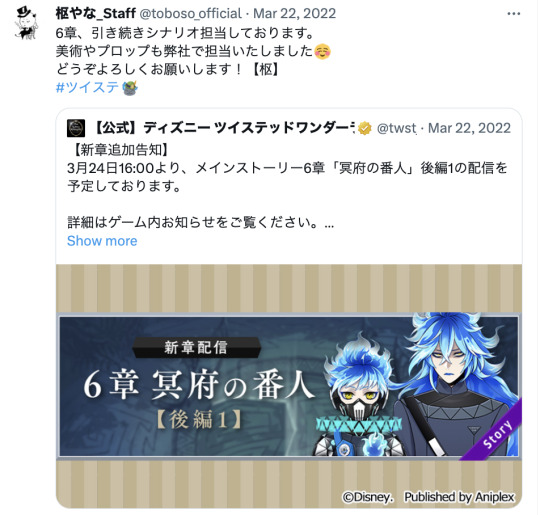
Ex: In this tweet Yana says that while she did the scenario herself, the backgrounds and prop designs were by her studio.
The Main Story
Starting with the release of part 1 of Book 3 on JP server, Yana explains that she did the scenario, original artwork for the SSR cards, directed the vignettes and was in charge of character design.

For Book 7 she says she did the scenario and original character art/character designs, while some prop designs and background visuals were done by her studio.
Card Art
For Ortho’s dorm uniform design Yana explains that both she and her studio did the original art from start to finish (she did the original concept and story for the vignette), while she alone was in charge of the before/after groovy art from start to finish for Idia’s dorm uniform card.
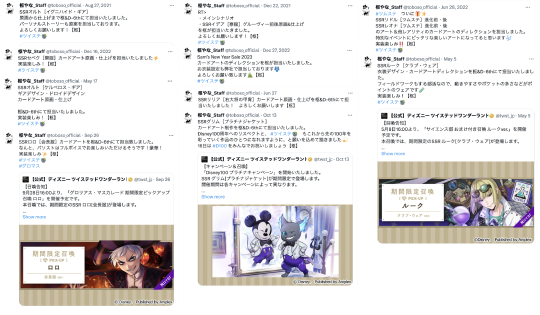
She did the art for Leona and Riddle’s tsumsted cards (and direction for the other cards in the series), Sebek’s dorm uniform art from start to finish and and did art direction for the cards in the 2022 New Year’s set, while costume design was done by her studio.
Rook’s Clubwear, Ortho’s Cerberus Gear, Lilia’s General card, Rollo’s card and Grim’s D100 card are all credited to both Yana and her studio.

(We got a rare comment with the release of Ortho’s Cerberus Gear where she said, “We have an artist working with us who spent almost 20 years doing backgrounds for a certain, extremely famous robot anime. She oversees a lot of the background art designing. The background for Ortho’s Cerberus Gear card, the aircraft catapult, the facility seen in the groovy art—that is all her work. It really captures the moment of take off! Professional background artists are truly amazing, capable of designing everything from S.T.Y.X.’s futuristic aircraft catapult to homages of famous watercolor masterpieces." That is one of the artists that Yana is referring to when a design is attributed to D-6th.)
Birthdays

Yana was credited with direction for the Birthday Boy series, while Ortho’s design and direction was credited to her studio.

Yana credited her studio with the Birthday Jacket designs and scenario creation, saying that she was in charge of direction for the series (with Ortho’s gear design, direction and room design all credited to her studio).

For the Broom/Bloom series Yana says that she participated in concept/costume design and was in charge of direction (with D-6th credited with the art direction and gear design for Ortho).

The art for the platinum series (including the backgrounds) is credited to the staff of D-6th, with Yana in charge of direction.
Events
Yana explains she did all the original art for all of the cards, the scenarios and direction for Beanfest, Fairy Gala and Phantom Bride (she also created the scenarios for all the vignettes).

She also created the story and did all of the card art and direction for Terror is Trending and Spectral Soiree.
For Port Fest she specified that she did the original art for Jack’s SSR and did direction for the remaining cards, crediting her studio with costume/background designs.
Yana created the scenario, character design, SSR card art (from start to finish) and did art direction for the R and SR cards of Glorious Masquerade, crediting herself and her studio with the costume/mask designs, background designs, and opening and ending screens.
She says she participated in card art direction for the R and SR cards in the Lost in the Book with Stitch event, crediting the costume designs, scenario creation, background visuals, SSR Lilia, SSR Floyd, original card art and creation to her studio.
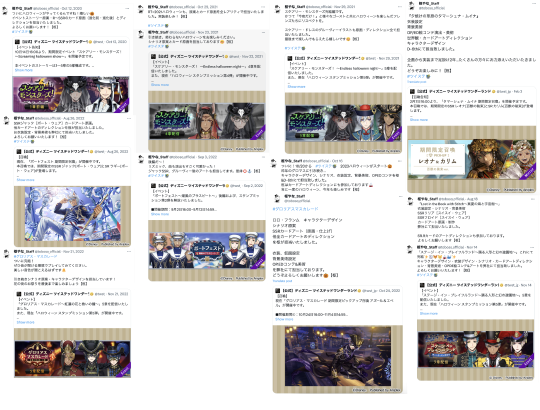
Stage in Playfulland character design, costume design, scenario creation, card art direction, background visuals and Opening/Ending art are also all credited to both Yana and her studio.
Novel
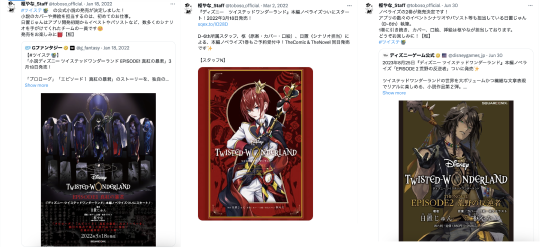
Yana says she was in charge of the concept, the in-novel art, cover and fold-out art in the novels, while Hioki Jun (a Twst vignette/event scenario writer) is the author.
Comic
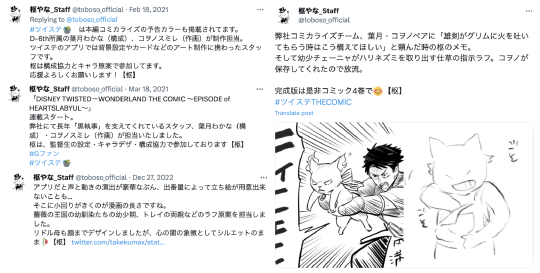
The artist and designer behind the 1st and 3rd comic arcs are both from Yana’s studio D-6th, doing background and card art for Twst (and one of them also works on Black Butler).
Yana says that her role is overall collaboration, character design and character creation (she says that in addition to creating the basis for Trey’s parents she also designed Riddle’s mother, including her face, but they ultimately left her in silhouette).
It is difficult to tell what Yana means by “overall collaboration," but she has shared a tweet about drawing the characters out herself for the official artists to base their work on. (This might not apply to the artist of the Savanaclaw arc, who is not a member of D-6th)
278 notes
·
View notes
Text
An Abbreviated History of Mecha Part 1: The Mighty Atomic Prelude (The 50's and 60's)

Welcome to An Abbreviated History of Mecha anime. Today, we're starting at, as Fraulein Maria would say, at the very beginning. We're taking a quick peak at the beginning of the canon, which means that we're starting back in 1950 (specifically 1952). I should also confess right now: there are two series on here that are demonstrably NOT mecha shows. However, due to their sheer influence on Japanese media as a whole, I feel it is important to bring them up as being honorary mecha shows due to their sheer influence pop culture.
Tetsuwan Atom/Mighty Atom/Astro Boy (1952)

Starting us off is Osamu Tezuka's seminal manga series, Mighty Atom. Known over here in the west as Astro Boy, this series would be what kickstarts a lot of the modern anime and manga industry due to its sheer popularity. Astro Boy would also be one of two series that would be emblematic of how Japanese pop culture would portray the recent use of atomic energy. It should also be worth noting that realizing that Astro technically is a mecha is what got me to start using a broader definition of mecha instead of the classic giant robot definition.
Due to its fame, Mighty Atom has receive multiple adaptations throughout the years. Of note are:
The original 1963 anime.
New Mighty Atom (1980) which updates the series to 1980's animation standards.
The 2003 anime, which does the same, but to the standards of early 2000's anime.
The 2009 CGI movie.
Gojira/Godzilla (1954, honorary mecha series 1)

1954 would also give us Ishiro Honda's Godzilla, the movie that would make tokusatsu-styled live action stories in Japan. Godzilla, alongside RKO's King Kong, would play a large part in popularizing the concept of kaiju. And boy will kaiju play a big part in the history of the mecha canon. As we'll see soon enough, the history of tokusatsu heroes, kaiju, and robots are all intertwined with one another.
Godzilla has starred in numerous movies since the original, but for stories based off of the original there are:
Godzilla Raids Again (1955), a direct sequel.
Godzilla, Mothra, King Ghidorah: All Out Monsters Attack (2001), a Heisei-era production that uses the original '54 Godzilla as a manifestation of the horrors of World War II.
Shin Godzilla (2016), a re-imagining of the original movie set in contemporary times directed by Hideakki Anno.
Godzilla Minus One (2023), the most recent outing inspired in part by GMK.
Tetsujin 28-go/Gigantor (1956)

(Oh hey, this gif again!)
Tetsujin 28-go is the creation of one Mitsuteru Yokoyama and is generally regarded as the grandfather of the giant robot style of mecha. Tetsujin is unique amongst mecha in that it is controlled not by a pilot riding inside of it, but by a little kid with a controller. Tetsujin 28, alongside Mazinger Z, would help to codify a lot of the tropes common to the classic superhero mecha anime that would be prevalent in the 70's. Like Mighty Atom, Tetsujin would receive multiple adaptations throughout the decades.
Shin Tetsujin 28-Go/The New Adventures of Gigantor (1980), which updates Tetsujin's design to look more in line with something like Mazniger Z.
Tetsujin 28-go FX (1992), sporting a radically different look that's more akin to something out of the Brave Franchise.
Tetsujin 28 (2004), a faithful adaptation of the original manga (at least I think it is) directed by Yasuhiro Imagawa.
Cyborg 009 (1964)

Created by Shotaro Ishinomori in 1964, Cyborg 009 is another classic human-sized mecha series. Cyborg 009 would be the first of many hits for Ishinomori, and he will be mentioned again later in this series.
Oh boy... I am not a Cyborg 009 nut, but in terms of adaptations, Cyborg 009 has:
The 1966 Film
The 1980 Film
009 Re:Cyborg (2012)
The Call For Justice Trilogy (2016)
The 1968 Anime
The 1979-1980 Anime
The 2001-2002 Anime (I actually remember when Toonami aired this series!)
Cyborg 009 vs Devilman (2015 OVA)
If you want to follow someone who follows a lot of Shotaro Ishinomori's works, I'd recommend checking out YouTuber Mercury Falcon for more info about Ishinomori.
Ultra Q and Ultraman (1966, honorary mecha series 2)

(The urge to use a gif of Ingraman is strong)
Ultra Q and Ultraman are the first two entries of Tsuburaya's legendary Ultra franchise, with the latter in particular being one of the most famous pop culture icons of all time. Ultraman's influence on Japanese media is so large, that I'll be mentioning it at least once in relation to other series later on.
Ultraman, like Godzilla before him, would get the Hideaki Anno treatment with Shin Ultraman in 2022.
Giant Robo/Johnny Sokko and His Flying Robot (1967)

Another one of Mitsuteru Yokoyama's classic manga series, Giant Robo deserves a mention due to its influence on tokusatsu. Giant Robo would usher in an era of tokusatsu that would rely on using giant robots as the main protagonist.
In terms of adaptations, there are two animated adaptations, but only one will be listed here:
GR: Giant Robo (2007)
If you want to learn a little bit more about the history behind Giant Robo, I'd recommend checking out blunova's video on Giant Robo for more info on this important series.
Conclusion
As the 60's would lead way into the 70's, we would see a lot more live action tokusatsu series involving giant robots. Of course, this would be untenable due to how expensive it was to do tokusatsu effects for television. However, one robot would appear in animation that would change everything.
(Read in the voice of Tessho Genda) AND ITS NAME IS...!!!!

#anime and manga#mecha#astro boy#mighty atom#tetsuwan atom#gigantor#tetsujin 28#cyborg 009#giant robo#ultraman#an abbreviated history of mecha#anime history#godzilla#gojira
55 notes
·
View notes
Link
The China National Space Administration (CNSA) has put out a call for international and industry partners to contribute science payloads to its Chang’e-8 lunar lander, set for launch to the Moon in 2028. The mission, which will involve a lander, a rover, and a utility robot, will be China’s first attempt at in-situ resource utilization on the Moon, using lunar regolith to produce brick-like building materials. Just like NASA’s Artemis plans, the CNSA’s plans for the Moon are targeted at the Lunar south pole, which is expected to be rich in useable resources, especially water. The presence of these resources will be vital for long-term human activity on the lunar surface. Possible landing sites for Chang’e-8 include Leibnitz Beta, Amundsen crater, Cabeus crater, and the ridge connecting the Shackleton and de Gerlache craters, according to a presentation by Chang’e-8 chief deputy designer in October 2023. Chang’e-8 will be the last CNSA robotic mission to be launched before construction begins on the International Lunar Research Station, China’s crewed moonbase being planned in collaboration with Russia’s Roscosmos. That makes Chang’e-8’s attempt to create building materials out of regolith a vital proof-of-concept for their lunar aspirations. In order to make moon-bricks, the lander will carry an instrument that uses solar energy to melt lunar soil and turn it into useable parts at a speed of 40 cubic cm per hour. Alongside the regolith processing equipment, the lander will be equipped with an array of science instruments, including cameras, a seismometer to detect moonquakes, and an x-ray telescope. Part of the mission will focus on moon-based Earth observation, with several instruments designed to monitor Earth’s atmosphere and magnetosphere. The rover, meanwhile, will carry ground penetrating radar, cameras, a mineral analyzer, and tools for collecting and storing samples (leaving open the possibility of future missions to retrieve the samples). The utility robot is a key piece of the mission, but CNSA isn’t developing it in-house. Instead, the space agency is seeking proposals from partners interested in developing it as a piggyback payload to ride alongside the rest of Chang’e-8. According to the call for proposals, the 100kg, battery-powered robot will need to be able to “capture, carry and place items, shovel, and transfer lunar soil.” It will also need to be able to travel at 400m per hour. There is room for an additional 100kg of piggyback payloads besides the robot, for which full proposals are expected to be submitted later this year. While planning for Chang’e 8 is ongoing, the CNSA has two additional robotic moon missions in the works for the near future. The first, Chang’e-6, will launch this spring, and aims to return a regolith sample from the lunar far side (a never before accomplished feat). The next mission is planned for 2026, when Chang’e-7 will carry out a geological examination of the permanently shadowed craters scattered around the Moon’s south pole. The post China's Chang'e-8 Mission Will Try to Make Bricks on the Moon appeared first on Universe Today.
95 notes
·
View notes
Text
So a slightly more coherant and non spoilery list of reasons you need to go see The Creator (2023)
The aesthetics alone are worth it
Seriously the film is so fucking pretty
Did you enjoy any of the following? Blade Runner, A.I. Artificial Intelligence, Akira, Ghost in the Shell, Serial Experiments Lain, Gattaca, Elysium, District 9?
Do you like precocious, adorable children characters?
Do you like the 'gruff action dude becomes a dad' trope?
Do you enjoy fiction about transhumanism, the 'ship of theseues' as it relates to humanity? How do you feel about themed about the horrors of imperalism and the military industrial complex
Cool robots
185 notes
·
View notes
Text
nuance haters dni
essentially, after doing personal research on this, here's where i stand:
ai is a neutral tool
ai is also more than chatgpt. a lot of the stuff you use on a day to day basis is ai but is NOT a large language learning model like chatgpt
capitalism is the problem
it should stay out of art and any business implementing it to steal from artists or replace labor should explode
it has genuine potential, particularly for accessibility
so many fucking privacy concerns oh my god
environmental effects are not great but have little to do with AI itself as a tool and mostly to do with exacerbations of our preexisting fossil fuel sources and what the AI is being used for. to be clear i'm not saying there's no environmental impact. there is. but it's a bit more complex than what people are envisioning - much the same way people don't think about the plastic in their phones when thinking about waste. there's simply not enough data collected on electricity output yet to run an actual regression, but major concerns are concerns that apply to the entire tech industry. the study most people are quoting when they talk about energy consumption is by alex devries in 2023. most environmental research peformed on LLMs is performed on their training phase and not their output phase, and the results of the output phase largely depend on the model being used. These data are also from 2023, and I'd wager some new data will become available soon. There is this one article that claims ChatGPT uses LESS energy than a google search - I do think this study is a bit biased, but they quote scholarly sources and have peer review. my conclusion here is: we need more data, but if anything, AI only makes me think the pressure and urgency for renewable energy is urgent - if these things were powered on solar or nuclear energy it would be negligible. the water cooling is a closed loop system, so it's the energy being used to cool the water that's a concern. AI is also housed within regular datacenters, it's not like it's a specific AI datacenter.
chatgpt/openAI specifically is concerning due to the lack of. regulation - reminds me of early hollywood days with studios with film monopolies
i used it once or twice to scope it out back when it came out thought it wasnt worth it, i think its lame that students are relying on it and its having negative effects on education but thats also a natural evolution for the ipad baby generation
i think whether or not you use AI largely comes down to a personal moral stance but that "the robots will kill us" is obviously a very prevalent factor in personal panic towards it. i personally don't use it bc it hasn't been very helpful, but i understand why some people would.
if you use it to generate big titty girl art or write books or whatever, PERISH
tl;dr: there are a ton of things that use a ton of energy and are bad for the planet. gaming PCs, for one, use a lot of energy! Certainly not as much as an entire data center, but all our regular google searches and cloud saves are going on in those data centers too, not to mention the environmental impact of mining for the materials that make up our chips, phones, computers, etc. AI illuminates some pressing needs for energy reform, but those aren't related to the nature of AI tools themselves. AI is legitimately concerning in privacy violations and lack of regulation, as well as what the tools are being used for. It should be regulated against quickly in art and education. in a perfect world, AI uses renewable energy to perform tasks that supplement human activity, not replace it
8 notes
·
View notes
Text
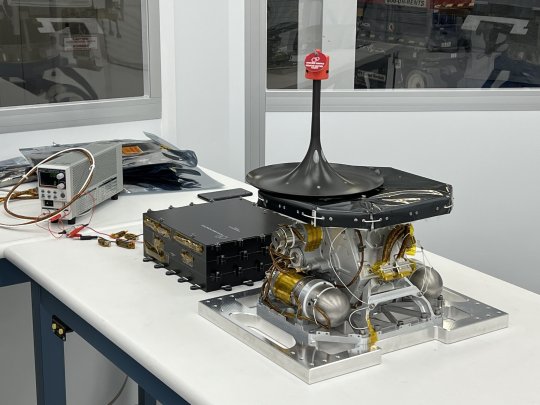
NASA payload aims to probe moon's depths to study heat flow
Earth's nearest neighboring body in the solar system is its moon, yet to date, humans have physically explored just 5% of its surface. It wasn't until 2023—building on Apollo-era data and more detailed studies made in 2011–2012 by NASA's automated GRAIL (Gravity Recovery and Interior Laboratory) mission—that researchers conclusively determined that the moon has a liquid outer core surrounding a solid inner core.
As NASA and its industry partners plan for continued exploration of the moon under Artemis in preparation for future long-duration missions to Mars, improving our understanding of Earth's 4.5-billion-year-old moon will help teams of researchers and astronauts find the safest ways to study and live and work on the lunar surface.
That improved understanding is the primary goal of a state-of-the-art science instrument called LISTER (Lunar Instrumentation for Subsurface Thermal Exploration with Rapidity), 1 of 10 NASA payloads flying aboard the next delivery for the agency's CLPS (Commercial Lunar Payload Services) initiative and set to be carried to the surface by Firefly Aerospace's Blue Ghost 1 lunar lander.
Developed jointly by Texas Tech University in Lubbock and Honeybee Robotics of Altadena, California, LISTER will measure the flow of heat from the moon's interior. Its sophisticated pneumatic drill will penetrate to a depth of 3 meters into the dusty lunar regolith.
Every half-meter it descends, the drilling system will pause and extend a custom-built thermal probe into the lunar regolith. LISTER will measure two different aspects of heat flow: thermal gradient, or the changes in temperature at various depths, and thermal conductivity, or the subsurface material's ability to let heat pass through it.
"By making similar measurements at multiple locations on the lunar surface, we can reconstruct the thermal evolution of the moon," said Dr. Seiichi Nagihara, principal investigator for the mission and a geophysics professor at Texas Tech. "That will permit scientists to retrace the geological processes that shaped the moon from its start as a ball of molten rock, which gradually cooled off by releasing its internal heat into space."
Demonstrating the drill's effectiveness could lead to more innovative drilling capabilities, enabling future exploration of the moon, Mars, and other celestial bodies. The science collected by LISTER aims to contribute to our knowledge of lunar geology, improving our ability to establish a long-term presence on the moon under the Artemis campaign.
Under the CLPS model, NASA is investing in commercial delivery services to the moon to enable industry growth and support long-term lunar exploration. As a primary customer for CLPS deliveries, NASA aims to be one of many customers on future flights. NASA's Marshall Space Flight Center in Huntsville, Alabama, manages the development of 7 of the 10 CLPS payloads carried on Firefly's Blue Ghost lunar lander.
IMAGE: LISTER (Lunar Instrumentation for Subsurface Thermal Exploration with Rapidity) is 1 of 10 payloads flying aboard the next delivery for NASA’s CLPS (Commercial Lunar Payload Services) initiative. The instrument is equipped with a drilling system and thermal probe designed to dig into the lunar surface. Credit: Firefly Aerospace
11 notes
·
View notes
Text
Excerpt from this story from Nation of Change:
China’s largest automaker, BYD, is selling its Dolphin hatchback EV for a low-low $15,000, complete with a 13-inch rotating screen, ventilated front seats, and a 260-mile range. Here in the U.S., you have to pay more than twice that price for the Tesla Model 3 EV ($39,000) with lower tech and only 10 more miles of driving range. In case $15K beats your budget, the Dolphin has a plug-in hybrid version with an industry-leading 74-mile range on a single charge for only $11,000 and an upgrade with an unbeatable combined gas-electric range of 1,300 miles. Not surprisingly, EVs surged to 52% of all auto sales in China last year. And with such a strong domestic springboard into the world market, Chinese companies accounted for more than 70% of global EV sales.
It’s time to face reality in the world of cars and light trucks. Let’s admit it, China’s visionary industrial policy is the source of its growing dominance over global EV production. Back in 2009-2010, three years before Elon Musk sold his first mass-production Tesla, Beijing decided to accelerate the growth of its domestic auto industry, including cheap, all-electric vehicles with short ranges for its city drivers. Realizing that an EV is just a steel box with a battery, and battery quality determines car quality, Beijing set about systematically creating a vertical monopoly for those batteries — from raw materials like lithium and cobalt from the Congo all the way to cutting-edge factories for the final product. With its chokehold on refining all the essential raw materials for EV batteries (cobalt, graphite, lithium, and nickel), by 2023-2024 China accounted for well over 80% of global sales of battery components and nearly two-thirds of all finished EV batteries.
Clearly, new technology is driving our automotive future, and it’s increasingly clear that China is in the driver’s seat, ready to run over the auto industries of the U.S. and the European Union like so much roadkill. Indeed, Beijing switched to the export of autos, particularly EVs, to kick-start its slumbering economy in the aftermath of the Covid lockdown.
Given that it was already the world’s industrial powerhouse, China’s auto industry was more than ready for the challenge. After robotic factories there assemble complete cars, hands-free, from metal stamping to spray painting for less than the cost of a top-end refrigerator in the U.S., Chinese companies pop in their low-cost batteries and head to one of the country’s fully automated shipping ports. There, instead of relying on commercial carriers, leading automaker BYD cut costs to the bone by launching its own fleet of eight enormous ocean-going freighters. It started in January 2024 with the BYD Explorer No. 1, capable of carrying 7,000 vehicles anywhere in the world, custom-designed for speedy drive-on, drive-off delivery. That same month, another major Chinese company you’ve undoubtedly never heard of, SAIC Motor, launched an even larger freighter, which regularly transports 7,600 cars to global markets.
Those cars are already heading for Europe, where BYD’s Dolphin has won a “5-Star Euro Safety Rating” and its dealerships are popping up like mushrooms in a mine shaft. In a matter of months, Chinese cars had captured 11% of the European market. Last year, BYD began planning its first factory in Mexico as an “export hub” for the American market and is already building billion-dollar factories in Turkey, Thailand, and Indonesia. Realizing that “20% to 30%” of his company’s revenue is at risk, Ford CEO Jim Farley says his plants are switching to low-cost EVs to keep up. After the looming competition led GM to bring back its low-cost Chevy Bolt EV, company Vice President Kurt Kelty said that GM will “drive the cost of E.V.s to lower than internal combustion engine vehicles.”
So, what does all this mean for America? In the past four years, the Biden administration made real strides in protecting the future of the country’s auto industry, which is headed toward ensuring that American motorists will be driving $10,000 EVs with a 1,000-mile range, a 10-year warranty, a running cost of 10 cents a mile, and 0 (yes zero!) climate-killing carbon emissions.
Not only did President Biden extend the critical $7,500 tax credit for the purchase of an American-made EV, but his 2021 Infrastructure Act helped raise the number of public-charging ports to a reasonable 192,000, with 1,000 more still being added weekly, reducing the range anxiety that troubles half of all American car owners. To cut the cost of the electricity needed to drive those car chargers, his 2022 Inflation Reduction Act allocated $370 billion to accelerate the transition to low-cost green energy. With such support, U.S. EV sales jumped 7% to a record 1.3 million units in 2024.
Most important of all, that funding stimulated research for a next-generation solid-state battery that could break China’s present stranglehold over most of the components needed to produce the current lithium-ion EV batteries. The solution: a blindingly simple bit of all-American innovation — don’t use any of those made-in-China components. With investment help from Volkswagen, the U.S. firm QuantumScape has recently developed a prototype for a solid-state battery that can reach “80% state of charge in less than 15 minutes,” while ensuring “improved safety,” extended battery life, and a driving range of 500 miles. Already, investment advisors are touting the company as the next Nvidia.
But wait a grim moment! If we take President Donald Trump at his word, his policies will slam the brakes on any such gains for the next four years — just long enough to potentially send the Detroit auto industry into a death spiral. On the campaign trail last year, Trump asked oil industry executives for a billion dollars in “campaign cash,” and told the Republican convention that he would “end the electrical vehicle mandate on day one” and thereby save “the U.S. auto industry from complete obliteration.” And in his victory speech last November, he celebrated the country’s oil reserves, saying, “We have more liquid gold than anyone else in the world.”
8 notes
·
View notes
Text

Bites is the first full-length studio album by Canadian industrial band Skinny Puppy, released as an LP through Nettwerk in 1985. It was reissued in 1993 on CD with additional material compiled from cassette releases, international releases, and previously undistributed tracks. The cover art was designed by Steven R. Gilmore.
Bites was certified gold by Music Canada on August 5, 1994.
The first CD release of Bites was on the compilation Bites and Remission in 1987. This release replaced the songs "Assimilate" and "The Choke" with remixed versions and it did not include all of the tracks featured on the earlier cassette release, which was significantly longer. A similar but distinct CD called Remission & Bites was released by Play It Again Sam in Europe during the same year. On the 1993 reissue, the song "One Day" is not listed anywhere in the artwork or credits.
The Tear Garden's self-titled EP from 1986 (one year after Bites originally saw release) includes a revised version of "The Centre Bullet" featuring vocals by Edward Ka-Spel, slightly retitled to "The Center Bullet." The two songs are identical save for the presence of vocals by The Legendary Pink Dots singer. Late reissues of The Tear Garden album Tired Eyes Slowly Burning also feature that version of "The Center Bullet". Having both been made by cEvin Key and Dave Ogilvie, it is unclear whether the track was originally a creation of Skinny Puppy or of The Tear Garden.
Billboard magazine recommended Bites, calling it a "strong club collection a la Kraftwerk". Tom Harrison of The Province gave the album a favorable review, calling it "willfully ugly and menacing", and described its songs as "cleanly produced" and "carefully textured". Tim DiGravina of AllMusic was also receptive, calling the album a "fascinating look at Skinny Puppy in embryonic form", and described its sound as "delicate and pristine". DiGravina also noted the influence of groups such as Depeche Mode, Human League, and Cabaret Voltaire.
Mike Abrams of the Ottawa Citizen thought Bites was depressing and for people with "undiscriminating tastes". He named the songs "Assimilate" and "Last Call" as the album's best tracks. James Muretich of the Calgary Herald was less impressed with Bites, calling the record "annoying" and likened the band to robots.
In 1999, Chart magazine listed Bites among the most influential Canadian albums of the 1980s.
In 2023 the album was the recipient of the Heritage Public Prize at the 2023 Polaris Music Prize.
9 notes
·
View notes
Text
The first step of technopolitics is not technological but political. It is about emancipating and decolonising, when not abolishing as a whole, the organisation of labour and social relations on which complex technical systems, industrial robots, and social algorithms are based — specifically their inbuilt wage system, property rights, and identity politics. Matteo Pasquinelli, 2023. The Eye of the Master: A Social History of Artificial Intelligence. London: Verso.
8 notes
·
View notes
Text
BEIJING (Reuters) - After quitting the education industry last August due to China's crackdown on private tutoring, He Ajun has found an unlikely second life as an unemployment influencer.
The Guangzhou-based vlogger, 32, offers career advice to her 8,400 followers, charting her journey through long-term joblessness. "Unemployed at 31, not a single thing accomplished," she posted last December.
He is now making around 5,000 yuan ($700) per month through ads on her vlogs, content editing, private consultations and selling handicrafts at street stalls.
"I think in future freelancing will be normalised," said He. "Even if you stay in the workplace, you'll still need freelancing abilities. I believe it will become a backup skill, like driving."
China is under instruction to unleash "new productive forces", with government policies targeting narrow areas of science and technology including AI and robotics.
But critics say that has meant weak demand in other sectors and risks leaving behind a generation of highly educated young people, who missed the last boom and graduated too late to retrain for emerging industries.
A record 11.79 million university graduates this year face unprecedented job scarcity amid widespread layoffs in white-collar sectors including finance, while Tesla, IBM and ByteDance have also cut jobs in recent months.
Urban youth unemployment for the roughly 100 million Chinese aged 16-24 spiked to 17.1% in July, a figure analysts say masks millions of rural unemployed.
China suspended releasing youth jobless data after it reached an all-time high of 21.3% in June 2023, later tweaking criteria to exclude current students.
Over 200 million people are currently working in the gig economy and even that once fast-growing sector has its own overcapacity issues. A dozen Chinese cities have warned of ride-hailing oversaturation this year.
Redundancies have even spread to government work, long considered an "iron rice bowl" of lifetime employment.
Last year Beijing announced a 5% headcount reduction and thousands have been laid off since, according to official announcements and news reports. Henan province trimmed 5,600 jobs earlier this year, while Shandong province has cut nearly 10,000 positions since 2022.
Meanwhile, analysts say China's 3.9 million vocational college graduates are mostly equipped for low-end manufacturing and service jobs, and reforms announced in 2022 will take years to fix underinvestment in training long regarded as inferior to universities.
China currently faces a shortage of welders, joiners, elderly caregivers and "highly-skilled digital talent", its human resources minister said in March.
Yao Lu, a sociologist at Columbia University, estimates about 25% of college graduates aged 23-35 are currently in jobs below their academic qualifications.
Many of China's nearly 48 million university students are likely to have poor starting salaries and contribute relatively little in taxes throughout their lifetimes, said one Chinese economist who asked not to be named because of the sensitivity of the issue.
"Although they cannot be called a 'lost generation', it is a huge waste of human capital," the person said.
'DOING THREE PEOPLE'S JOBS'
Chinese President Xi Jinping in May urged officials to make job creation for new graduates a top priority. But for younger workers unemployed or recently fired, the mood is bleak, nine people interviewed by Reuters said.
Anna Wang, 23, quit her state bank job in Shenzhen this year due to high pressure and frequent unpaid overtime. For a salary of about 6,000 yuan per month, "I was doing three people's jobs," she said.
Her ex-colleagues complain about widespread pay cuts and transfers to positions with unmanageable workloads, effectively forcing them to resign. Wang now works part-time jobs as a CV editor and mystery shopper.
At a July briefing for foreign diplomats about an agenda-setting economic meeting, policymakers said they have been quietly urging companies to stop layoffs, one attendee told Reuters.
Olivia Lin, 30, left the civil service in July after widespread bonus cuts and bosses hinted at further redundancies. Four district-level bureaus were dissolved in her city of Shenzhen this year, according to public announcements.
"The general impression was that the current environment isn't good and fiscal pressure is really high," she said.
Lin now wants a tech job. She has had no interview offers after a month of searching. "This is completely different from 2021, when I was guaranteed one job interview a day," she said.
REDUCED STIGMA
Shut out of the job market and desperate for an outlet, young Chinese are sharing tips for surviving long-term unemployment. The hashtags "unemployed", "unemployment diary" and "laid off" received a combined 2.1 billion views on the Xiaohongshu platform He uses.
Users describe mundane daily routines, count down the days since being fired, share awkward chat exchanges with managers or dole out advice, sometimes accompanied by crying selfies.
The increasing visibility of jobless young people "increases broader social acceptance and reduces stigma surrounding unemployment", said Columbia's Lu, allowing otherwise isolated youth to connect and "perhaps even redefine what it means to be unemployed in today's economic climate".
Lu said unemployed graduates understood blaming the government for their plight would be both risky and ineffective. Rather, she said, they were more likely to slip into "an internalisation of discontent and blame" or "lying flat".
He, the influencer, thinks graduates should lower their ambitions.
"If we have indeed entered 'garbage time', then I think young people could accumulate skills or do something creative, such as selling things via social media or making handicrafts."
11 notes
·
View notes